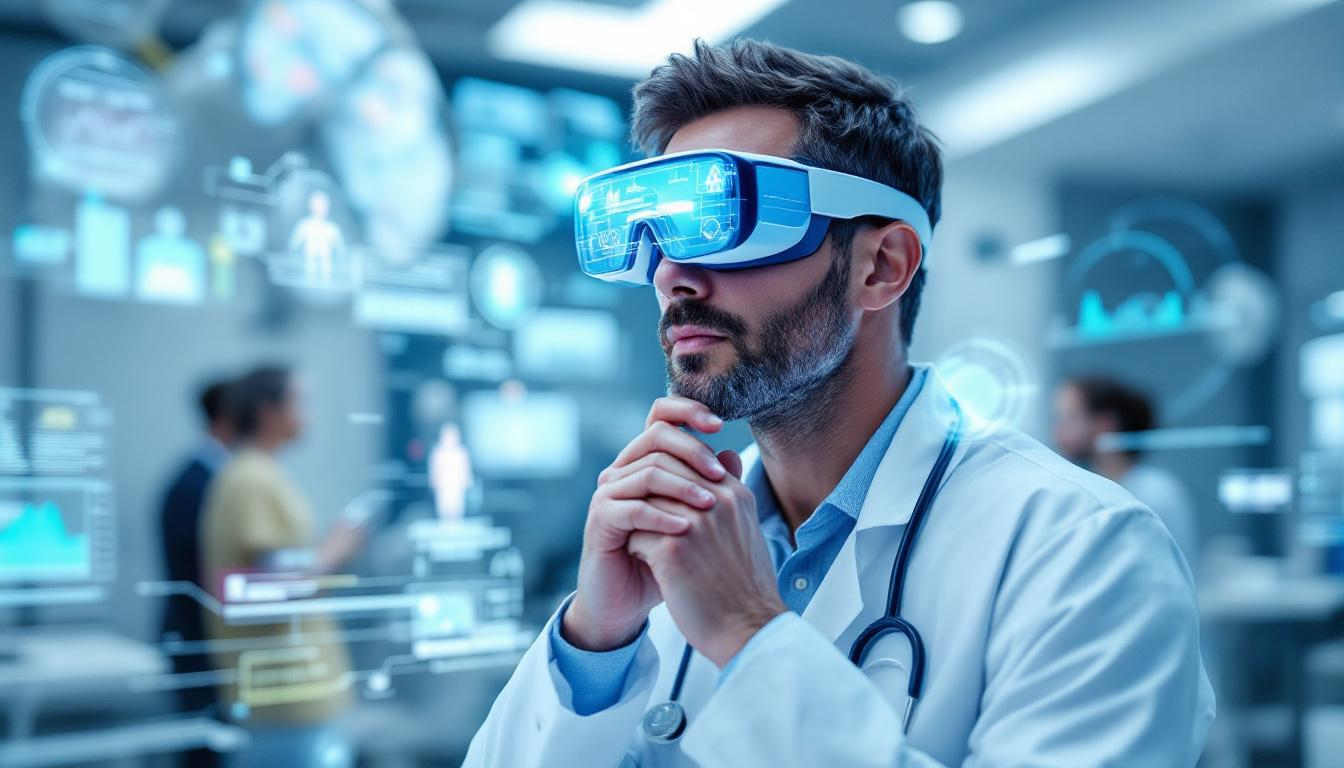.png)
Augmented Reality (AR) is swiftly revolutionizing the healthcare sector by merging theoretical learning with practical application. By superimposing digital data onto the physical world, AR provides immersive and interactive experiences that are transforming medical education and virtual care. From facilitating intricate anatomical studies to boosting surgical accuracy and enhancing patient interaction, AR is setting new benchmarks in healthcare education and service delivery.
Immersive Medical Training: A New Era of Learning
Traditional medical education often depends on textbooks, cadaver dissections, and observation, which can restrict hands-on experience and spatial comprehension. AR revolutionizes this by creating interactive, 3D learning environments where students and professionals can explore complex anatomical structures in unprecedented detail.
Medical schools are increasingly integrating AR to enable virtual dissections and explorations of organs like the brain, heart, and lungs. These 3D models allow learners to manipulate and examine structures from various angles, fostering a deeper understanding of human anatomy. This approach not only enhances retention but also prepares students for real-world clinical scenarios by simulating hands-on experiences without the ethical and logistical constraints of cadaver labs. More about these innovative training methods can be found at LetsNurture.
Moreover, AR platforms like Touch Surgery offer surgical simulations where medical professionals can practice procedures in a risk-free virtual environment. These simulations replicate the tactile and visual feedback of actual surgeries, allowing users to refine their skills before operating on live patients. This hands-on practice is invaluable for building confidence and competence, especially in complex or rare procedures.
Remote Collaboration and Accessibility
One of the most compelling advantages of AR in medical training is its ability to connect learners and experts across geographical boundaries. AR enables remote collaboration where students in different cities can simultaneously interact with the same 3D anatomical models, practicing procedures and receiving real-time feedback. This democratizes access to high-quality medical education, especially in regions where resources or expert instructors are scarce.
Augmented Reality in Surgical Procedures: Precision and Collaboration
AR is making significant strides in the operating room by enhancing surgical precision and enabling real-time collaboration among specialists. Surgeons now use AR headsets, such as the Apple Vision Pro, to overlay detailed 3D models of patient anatomy directly onto their field of view during operations. This technology provides critical insights into the patient’s internal structures without diverting attention away from the surgical site.
At institutions like UC San Diego, surgeons have successfully performed over 20 minimally invasive surgeries using AR headsets, resulting in improved accuracy and reduced risk of complications. By visualizing the patient’s anatomy in real time, surgeons can navigate complex procedures with greater confidence and efficiency. This integration of AR into surgical workflows is a game-changer for patient safety and outcomes. More details on these advancements are available at Time.
Remote Surgical Assistance
AR also facilitates remote surgical assistance, allowing experts worldwide to collaborate during live procedures. Platforms like Proximie enable specialists to annotate surgical feeds and guide operations virtually, providing access to specialized knowledge without the need for patient or expert travel. This capability is especially valuable in emergency situations or in regions lacking certain surgical expertise, ensuring patients receive the best possible care regardless of location.
Enhancing Patient Care Through Augmented Reality
Beyond training and surgery, AR is improving patient education and rehabilitation, making healthcare more interactive and personalized. Patients often struggle to understand their medical conditions and treatment plans, which can lead to anxiety and non-compliance. AR addresses this by visualizing complex procedures and conditions in an accessible, engaging way.
For example, cardiologists use AR animations to demonstrate how stents are inserted into blocked arteries, helping patients visualize the process and understand the benefits of the treatment. This interactive education fosters better communication between healthcare providers and patients, increasing trust and adherence to medical advice. Learn more about patient-centric AR applications at Simbott.
Rehabilitation and Physical Therapy
AR is also transforming rehabilitation by guiding patients through customized exercises at home. These applications provide real-time feedback on form and technique, ensuring exercises are performed correctly and effectively. This approach reduces the need for frequent in-person visits, making therapy more convenient and engaging, which can improve patient outcomes and reduce healthcare costs.
Market Growth and Industry Adoption
The adoption of AR in healthcare is accelerating, driven by technological advancements and growing recognition of its benefits. The global AR and VR healthcare market was valued at USD 1.03 billion in 2024 and is projected to grow at a compound annual growth rate (CAGR) of 15.4% between 2025 and 2030. This rapid expansion reflects increasing investments, innovation, and integration of AR solutions across medical disciplines.
Regulatory bodies are also supporting this growth. The U.S. Food and Drug Administration (FDA) approved over 30 new AR/VR-based medical devices between 2022 and 2023, signaling growing acceptance and trust in these technologies. Such regulatory endorsements are crucial for widespread clinical adoption and patient safety assurance. More insights on market trends can be found at GlobeNewswire.
Challenges and Considerations in AR Healthcare Integration
Despite its promise, integrating AR into healthcare systems presents several challenges. High development and hardware costs can limit accessibility, especially for smaller institutions or those in low-resource settings. Additionally, ensuring seamless integration with existing workflows requires strategic planning and collaboration across multidisciplinary teams.

Data privacy and security represent critical concerns. AR applications handle sensitive patient information, and the digital transmission and storage of this data expose healthcare organizations to cybersecurity risks. In 2023, approximately 77% of healthcare organizations reported cybersecurity incidents, underscoring the need for robust data protection measures in AR systems. Addressing these issues involves implementing secure management systems and adhering to strict regulatory compliance standards. More on these challenges is discussed at RealVNC.
The Future of AR in Medical Training and Virtual Care
As AR technology continues to evolve, its role in healthcare is expected to expand further. Advances in artificial intelligence, 5G connectivity, and wearable devices will enhance AR’s capabilities, making it more intuitive, responsive, and accessible. This evolution promises to improve not only medical education and surgical outcomes but also patient engagement and remote care delivery.
Healthcare providers and educators who embrace AR stand to benefit from improved training efficiency, enhanced procedural accuracy, and enriched patient experiences. While challenges remain, the ongoing collaboration between technology developers, medical professionals, and regulatory agencies is paving the way for AR to become an indispensable tool in modern medicine.
In conclusion, augmented reality is reshaping the landscape of medical training and virtual care by offering immersive, interactive solutions that improve learning, precision, and patient involvement. As this technology matures, it will continue to unlock new possibilities for healthcare innovation and excellence.
Related posts
The operating system for value-based care
And experience the impact of telemedicine within your organisation





%20(1)%20(1).png)